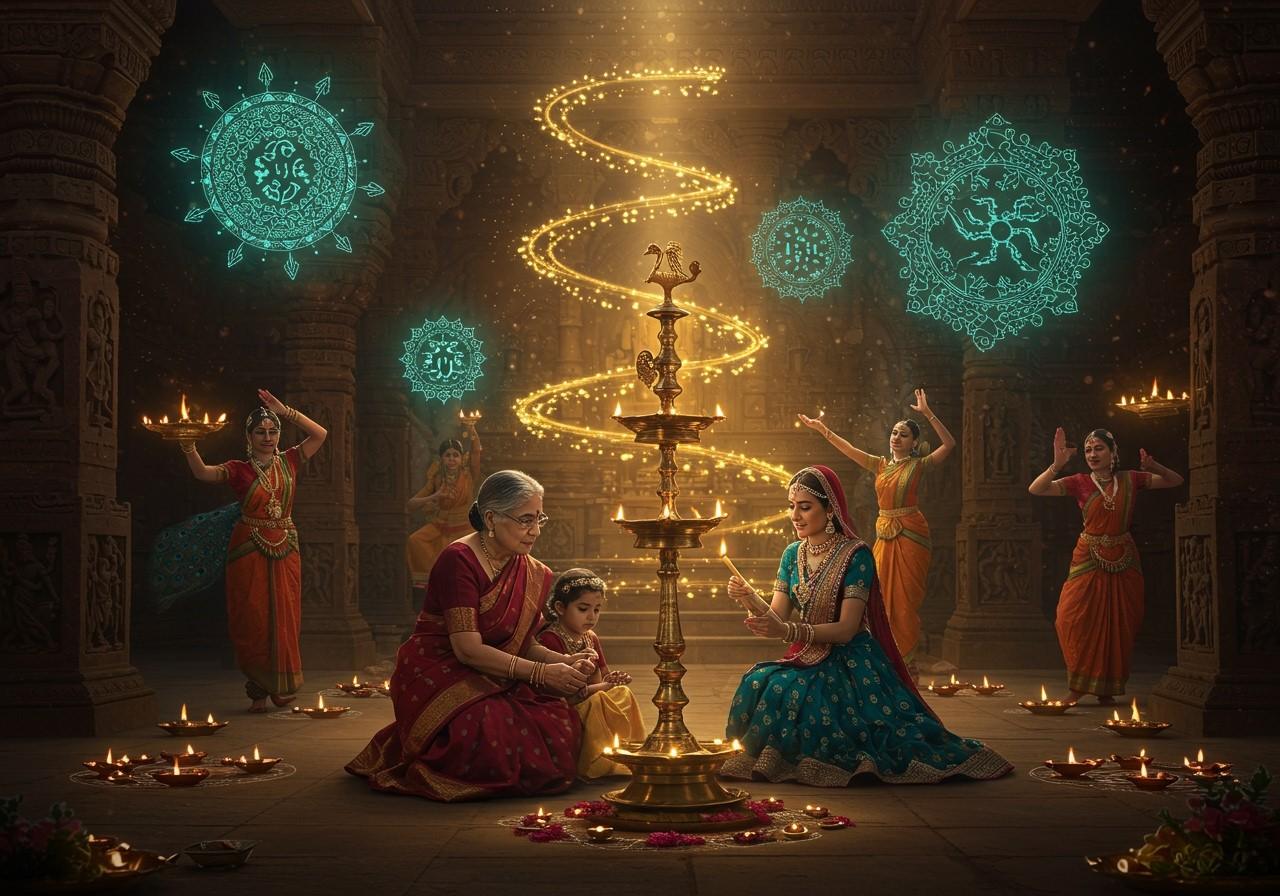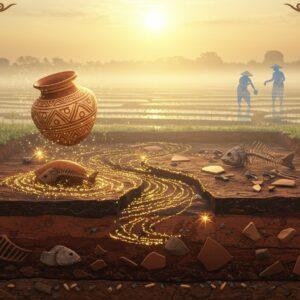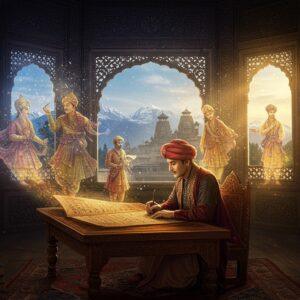
In the rich tapestry of Indian culture, Sampradaya holds a special place. It represents the deeply rooted traditions and philosophies that have shaped the Indian subcontinent. This term, originating from Sanskrit, describes a traditional school of thought or religious system within Hinduism. As our world modernizes rapidly, understanding and preserving these traditions is crucial for maintaining our cultural heritage. You can find various products related to Hindu traditions and rituals on Poojn.in, India’s leading online store for cultural goods.
Understanding Sampradaya and Darshan
Sampradaya and Darshan are closely connected concepts in Indian philosophy. Sampradaya refers to a lineage of spiritual teachers and teachings within a specific tradition, providing structure and continuity. Darshan, on the other hand, means a philosophical system or viewpoint, offering a specific lens through which to understand reality. Each Sampradaya is linked to a particular Darshan, offering a structured way to interpret spiritual truths. Major Darshans include Vedanta, Mimamsa, and Nyaya, each with affiliated Sampradayas. These philosophies greatly influence religious practices, rituals, and everyday life in India. The Guru-Shishya (teacher-disciple) lineage plays an essential role in preserving and passing down these traditions.
Janapada Sampradaya: The Folk Traditions of India
India’s cultural diversity shines through its Janapada Sampradaya, the folk traditions tied to specific regions and communities. These traditions showcase the rich variety of music, dance, storytelling, and oral histories unique to each area. This includes practices related to local deities, harvest festivals, and community celebrations. Take the Bhakti and Sufi traditions, for instance. They cross regional lines while maintaining a local essence, demonstrating the dynamic interplay between shared spiritual principles and unique regional expressions.
The vibrant colors of Janapada Sampradaya contribute to India’s cultural mosaic. They serve as a medium for imparting moral and ethical teachings, passed down through generations. Festivals and community gatherings are crucial in keeping these traditions alive. Events like Diwali and Holi bring people together, celebrating with rituals that strengthen community bonds and reinforce cultural values.
Learn more about Holi celebrations here.
Sampradaya Dance of India: A Spiritual Expression
Classical Indian dance forms are deeply connected to religious and philosophical traditions. Bharatanatyam, Kathak, Odissi, and Kathakali are major dance forms rooted in specific Sampradayas and regions. Each dance tells a story through intricate movements and music, conveying complex narratives and emotions. This storytelling aspect is central to conveying spiritual narratives and preserving cultural heritage. Dedicated practice and a deep understanding of the underlying traditions are essential for mastering these art forms. Dive into the world of Hindu art and culture here.
Dance plays a vital role in temple rituals, offering a form of devotion and storytelling. Over time, it has evolved into a performing art form, captivating audiences worldwide. Yet, preserving these traditional dance forms in modern times presents challenges. Efforts to safeguard them include promoting cultural awareness and education, ensuring future generations appreciate and continue these art forms.
Cultural Significance and Evolution of Sampradaya
Sampradaya holds a crucial place in shaping Indian identity. These traditions, including rituals, beliefs, and social practices, developed during ancient and medieval times and continue to evolve. This evolution is a testament to their adaptability and relevance in a changing world. They continue to adapt to modern influences, reflecting the dynamic nature of culture. Globalization and digital media have impacted Sampradaya practices, making them more accessible to wider audiences.
Initiatives promoting cultural preservation play an essential role in this evolution. Organizations dedicated to educating people about Sampradaya ensure these traditions thrive. Personal and collective identities are shaped by adhering to these practices, fostering a sense of belonging and continuity.
Online Platforms and Accessibility of Sampradaya
In today’s digital age, online platforms offer new opportunities for promoting Sampradaya and Indian culture. Digital tools and e-commerce make traditional ritual items, like those available on Poojn.in, more accessible worldwide. Virtual platforms enable cultural exchange and learning, breaking down geographical barriers. This digital presence allows for a wider dissemination of knowledge and practices. This is especially beneficial for the Indian diaspora, connecting them with their cultural roots.
However, maintaining authenticity in the digital realm poses challenges. Successful online initiatives have enhanced cultural awareness and participation, allowing people to connect with their roots more easily. They also provide platforms for discussion and learning, fostering a deeper understanding of Sampradaya.
Poojn.in: Supporting Your Cultural Journey
Poojn.in assists you in preserving and practicing Indian traditions by offering authentic puja items and cultural resources. For Saraswati puja and worship, Poojn offers essential items like pure cotton wicks, brass oil lamps, and traditional flowers. Students and musicians can find specially curated Saraswati puja kits like this that contain all the necessary items for proper worship. Alta, another important item for puja, is also available.
Poojn.in also offers a wide variety of spiritual products, including wool asans for meditation and puja, incense sticks for creating a sacred atmosphere, and Laddu Gopal murtis. Additionally, you can find traditional items like the Keya Kouto sindur dibbi.
Embracing Sampradaya in Modern Times
In our rapidly changing world, the essence of Sampradaya remains a guiding light. These traditions provide a sense of belonging, connecting us to our roots and offering a framework for understanding our place in the world. By actively participating in and valuing these practices, we contribute to their continued vibrancy, ensuring they are passed on to future generations.
The digital age presents exciting new ways to explore and appreciate our heritage. Online platforms make the richness of Indian culture readily accessible, facilitating learning, sharing, and participation in Sampradaya regardless of location. This accessibility fosters deeper understanding and appreciation, connecting individuals with their heritage in profound ways.
Understanding Sampradaya and Indian Culture: Frequently Asked Questions
What is Sampradaya in Indian culture? Sampradaya encompasses the traditions, schools of thought, teachings, rituals, and practices passed down through generations. These traditions serve as a vital link to the past, preserving cultural and spiritual heritage. They provide a framework for understanding the world and our place within it.
How does Sampradaya influence Indian culture? Sampradaya shapes Indian culture by transmitting customs, values, and beliefs. It provides structure for rituals and practices, ensuring these traditions remain relevant in modern times. This continuity connects individuals to their heritage and provides a sense of belonging.
What is the connection between Sampradaya and Darshan? Darshan represents philosophical viewpoints, while Sampradaya is the tradition that embodies and transmits these philosophies. Each Sampradaya is aligned with a particular Darshan, guiding followers on their spiritual path. This connection ensures philosophical underpinnings are preserved and practiced within the tradition.
Can you explain Janapada Sampradaya? Janapada Sampradaya refers to India’s folk traditions. These include regional art forms, music, dance, and storytelling, reflecting the rich cultural diversity and social nuances of different communities. These traditions offer unique insights into local customs and beliefs.
What is the role of Sampradaya in Indian classical dance? Sampradaya plays a vital role in preserving the authenticity and integrity of Indian classical dance. Each dance form adheres to a specific Sampradaya, ensuring adherence to traditional techniques, styles, and narratives. This dedication to tradition maintains the purity and richness of these art forms.
How does Sampradaya dance differ from other dance forms? Sampradaya dance emphasizes tradition, precision, and spiritual expression. Unlike contemporary dance forms, it focuses on storytelling through precise gestures, expressions, and postures rooted in cultural heritage. This focus on tradition sets it apart and reinforces its cultural significance.
Why is it important to preserve Sampradaya in modern times? Preserving Sampradaya is vital for maintaining cultural identity and heritage in a globalized world. It provides a connection to one’s roots, offering a sense of belonging and continuity. It also enriches the cultural tapestry of India, contributing to its diversity and vibrancy.
How can one learn about different Sampradayas? You can explore different Sampradayas through various avenues: attending cultural festivals, engaging with community groups, studying under a Guru, or researching online. Immersing oneself in local traditions and learning from elders provides invaluable insights into these rich traditions.
As we navigate the complexities of modern life, let us embrace the values and teachings of Sampradaya. By doing so, we honor our past, enrich our present, and inspire a future where these traditions continue to thrive, carrying forward the timeless spirit of Indian culture. Explore more about Indian spirituality and philosophy here.


